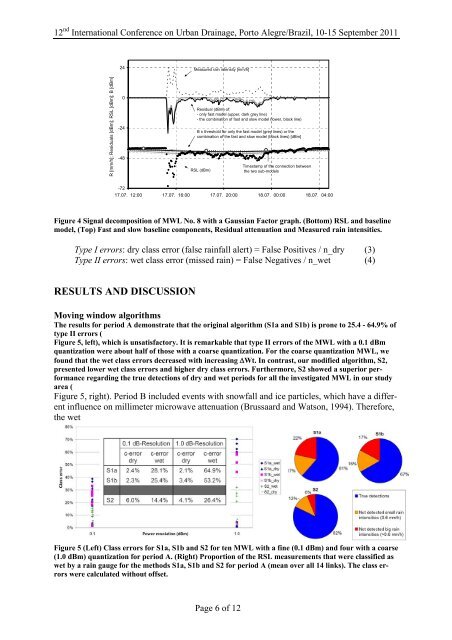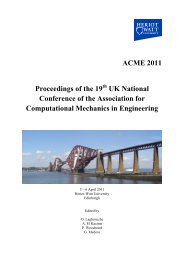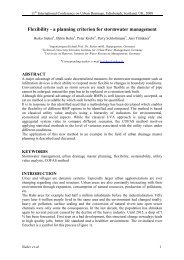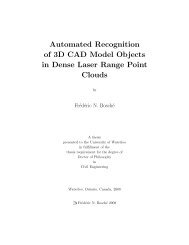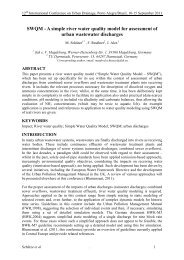Identification of dry and rainy periods using telecommunication ...
Identification of dry and rainy periods using telecommunication ...
Identification of dry and rainy periods using telecommunication ...
Create successful ePaper yourself
Turn your PDF publications into a flip-book with our unique Google optimized e-Paper software.
12 nd International Conference on Urban Drainage, Porto Alegre/Brazil, 10-15 September 2011<br />
R [mm/h]; Residuals [dBm]; RSL [dBm]; B [dBm]<br />
24<br />
0<br />
-24<br />
-48<br />
Measured rain intensity [mm/h]<br />
Residual (dBm) <strong>of</strong>:<br />
- only fast model (upper, dark grey line)<br />
- the combination <strong>of</strong> fast <strong>and</strong> slow model (lower, black line)<br />
B ± threshold for only the fast model (grey lines) or the<br />
combination <strong>of</strong> the fast <strong>and</strong> slow model (black lines) [dBm]<br />
RSL (dBm)<br />
-72<br />
17.07. 12:00 17.07. 16:00 17.07. 20:00 18.07. 00:00 18.07. 04:00<br />
Page 6 <strong>of</strong> 12<br />
Timestamp <strong>of</strong> the connection between<br />
the two sub-models<br />
Figure 4 Signal decomposition <strong>of</strong> MWL No. 8 with a Gaussian Factor graph. (Bottom) RSL <strong>and</strong> baseline<br />
model, (Top) Fast <strong>and</strong> slow baseline components, Residual attenuation <strong>and</strong> Measured rain intensities.<br />
Type I errors: <strong>dry</strong> class error (false rainfall alert) = False Positives / n_<strong>dry</strong> (3)<br />
Type II errors: wet class error (missed rain) = False Negatives / n_wet (4)<br />
RESULTS AND DISCUSSION<br />
Moving window algorithms<br />
The results for period A demonstrate that the original algorithm (S1a <strong>and</strong> S1b) is prone to 25.4 - 64.9% <strong>of</strong><br />
type II errors (<br />
Figure 5, left), which is unsatisfactory. It is remarkable that type II errors <strong>of</strong> the MWL with a 0.1 dBm<br />
quantization were about half <strong>of</strong> those with a coarse quantization. For the coarse quantization MWL, we<br />
found that the wet class errors decreased with increasing �Wt. In contrast, our modified algorithm, S2,<br />
presented lower wet class errors <strong>and</strong> higher <strong>dry</strong> class errors. Furthermore, S2 showed a superior performance<br />
regarding the true detections <strong>of</strong> <strong>dry</strong> <strong>and</strong> wet <strong>periods</strong> for all the investigated MWL in our study<br />
area (<br />
Figure 5, right). Period B included events with snowfall <strong>and</strong> ice particles, which have a different<br />
influence on millimeter microwave attenuation (Brussaard <strong>and</strong> Watson, 1994). Therefore,<br />
the wet<br />
Figure 5 (Left) Class errors for S1a, S1b <strong>and</strong> S2 for ten MWL with a fine (0.1 dBm) <strong>and</strong> four with a coarse<br />
(1.0 dBm) quantization for period A. (Right) Proportion <strong>of</strong> the RSL measurements that were classified as<br />
wet by a rain gauge for the methods S1a, S1b <strong>and</strong> S2 for period A (mean over all 14 links). The class errors<br />
were calculated without <strong>of</strong>fset.


